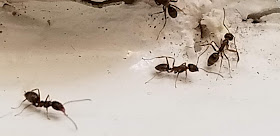Springfield Plateau Chapter of the Missouri Master Naturalist™ is a community based natural resource education and volunteer program. Its purpose is to develop a corps of well-informed volunteers to provide education, outreach and service dedicated to the beneficial management of natural resources and natural areas within their communities for the State of Missouri.
Missouri Master Naturalists- Springfield Plateau Chapter
▼
Tuesday, February 5, 2019
Invasive Ants
During our recent stay in Berkeley, California, we noticed tiny little ants measuring 3mm that would scout both the bathrooms and the kitchen sink, apparently coming in along the plumbing. They were few in number but very regular visitors as though they hadn't found what they were looking for. I sent a photograph to Dr. James Trager who identified them as Linepithema humile, a.k.a. the Argentine ant. He calls them "the invasive ant that ate coastal California." Internationally they are ranked in the top 100 animal invaders.
Antwiki describes this ant as one of the most well known of the invasive ants. They form "supercolonies" such as the Very Large Colony, which extends from San Diego to beyond San Francisco, may have a population of nearly one trillion individuals. "They have been extraordinarily successful, in part, because different nests of the introduced Argentine ants seldom attack or compete with each other, unlike most other species of ant. In their introduced range, their genetic makeup is so uniform that individuals from one nest can mingle in a neighboring nest without being attacked." Wikipedia
Our Berkeley ants seemed to be roaming around on the sniff with no apparent trail or followers. Recent ant research describes ant navigation techniques, summarized in this NY Times science feature. Go straight to the video at the top which says it all.
Warning! If you go to the bottom of the page you will be dragged down a rabbit hole (make that an ant hole) of fascinating articles about ants that have farmed fungus for millions of years and ants that explode to repel invading ants in their colony.
